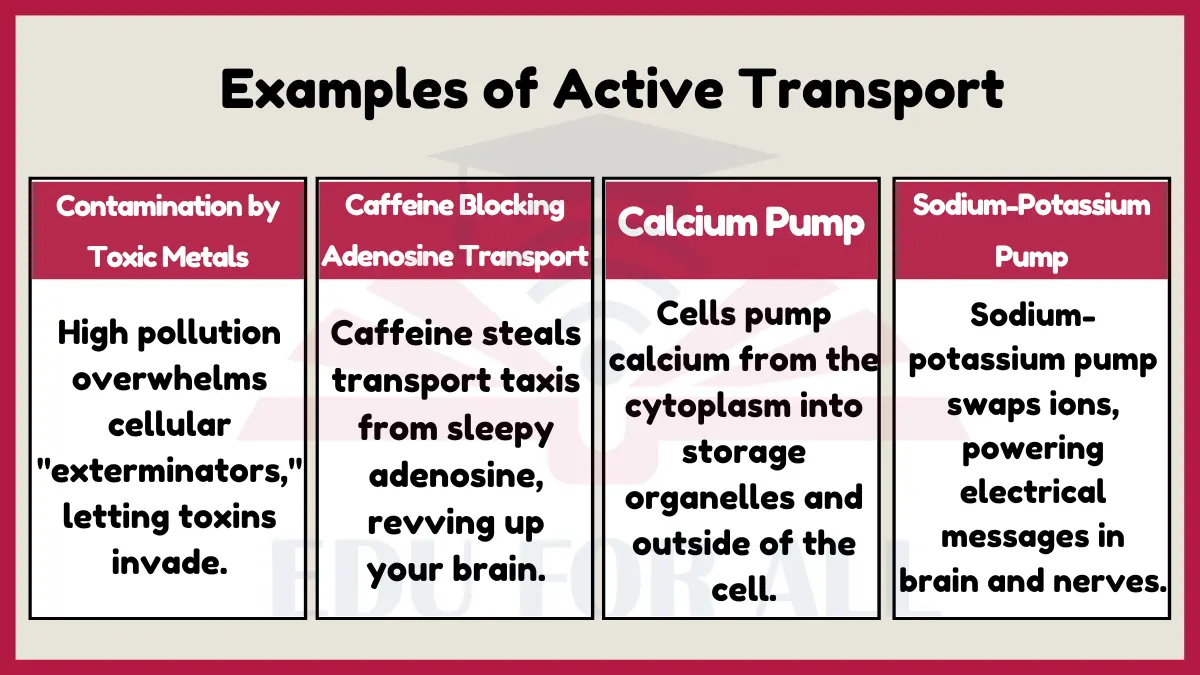Sodium-potassium pump, proton pump, endocytosis, exocytosis, cotransport of glucose and sodium ions, hydrogen ion pump, and the sodium-calcium exchanger are common examples of active transport processes.

Examples of Active Transport
Here are some Examples of Active Transport:
1: Contamination by Toxic Metals
ATP-powered membrane transport proteins that pump toxic metals like arsenic and mercury out of cells can get overloaded by high environmental contamination. The metals may accumulate inside cells without active pumping to remove them.
Experiment: Grow plants in contaminated and normal soil. Measure heavy metal uptake by analyzing metal concentrations in the plant tissues using atomic absorption spectroscopy. The contaminated plants will show higher accumulation of metals due to overloaded transport proteins.
2: Caffeine Blocking Adenosine Transport
Caffeine molecules can fit into cell membrane transporters meant for the molecule adenosine. By blocking reuptake transporters for adenosine, caffeine causes stimulatory effects since adenosine accumulates outside cells instead of being pumped back in.
Experiment: Expose frog oocytes injected with adenosine transporter RNA to caffeine. Use a radionucleotide imaging technique to quantify adenosine transport over time. Caffeine-treated cells will display blocked adenosine uptake compared to controls.
3: Using ATP-Binding Cassette Transporters to Remove Chemotherapy Drugs
Some cancer cells overexpress certain ATP-fuelled membrane pumps. By pumping chemotherapy drugs out of tumor cells, these ATP-binding cassette transporters contribute to multi-drug resistance in cancer treatment when the drugs get expelled faster than they can kill tumor cells.
Experiment: Treat human cancer cells overexpression transporters and normal cancer cells with a chemotherapy drug. Use an MTT cytotoxicity assay to evaluate cell death rates. The transporter-enhanced cells will show greater resistance and survival due to increased drug efflux.
4: Sodium-Potassium Pump
The sodium-potassium pump moves sodium and potassium ions against their concentration gradients. Cells pump 3 sodium ions out of the cell for every 2 potassium ions pumped in. This allows cells to maintain different sodium and potassium concentrations inside and outside which is important for generating electrical signals.
Experiment: Observe neurons firing under a microscope before and after being treated with ouabain, which blocks the sodium-potassium pump. Lack of firing shows the pump is important for neuronal signaling.
5: Calcium Pump
Cells pump calcium from the cytoplasm into storage organelles and outside of the cell. This maintains a much lower calcium concentration in the cell cytosol compared to outside. Calcium signaling depends on this gradient of low calcium inside and higher calcium outside cells.
Experiment: Treat muscle cells with a calcium-sensitive dye. Observe using fluorescence microscopy when calcium levels rise inside cells as they contract and then are pumped back out.
6: Proton Pumps
Proton pumps move hydrogen ions (H+) across membranes, often pumping them into intracellular compartments to lower the pH. The electron transport chain uses proton pumps to push H+ ions into the space between mitochondrial membranes, generating ATP in the process.
Experiment: Measure pH changes inside and outside cells using pH probes to detect active pumping of hydrogen ions.
7: ATP-binding Cassette Transporters
These membrane transporters use ATP to fuel the movement of various molecules such as lipids, drugs, and toxins out of cells against their gradients. They help remove waste and harmful substances from cells.
Experiment: Measure drug resistance in cell cultures with increased ATP-binding cassette transporters compared to normal cells. Increased pumping of drugs out of resistant cells will be evident.
8: Glutamate Transport in Neurons
Glutamate transporters in neuron cell membranes harness ATP to pump excess glutamate neurotransmitters back into neurons. This recycling of glutamate allows neurons to fire signals rapidly while preventing overstimulation from too much extracellular glutamate.
Experiment: Introduce transporter inhibitors to neuron cultures and measure extracellular glutamate levels. Lack of transporter function will lead to high, toxic glutamate accumulation outside cells.
Also Read:

